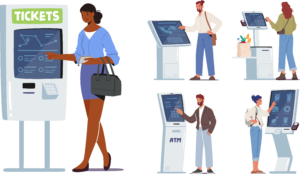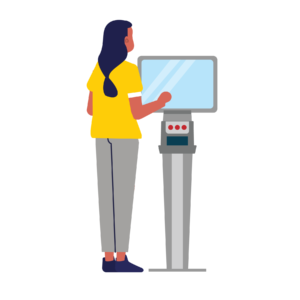3 Reasons Ophthalmology Practices Prefer Kiosk Patient Engagement Software
By Blakely Roth | April 26, 2023
Kiosks are a common and convenient form of interaction between consumers and businesses. From airport check-in to grocery store checkout and even fast-food ordering and pickup — businesses are seeing significant benefits from self-service kiosks. Healthcare is no exception. High-growth ophthalmology practices, along with other successful specialty practices, are adopting kiosk patient engagement software to speed up throughput and increase collections. They’re seeing nearly immediate revenue results.
Kiosk patient engagement software allows for a more efficient way to engage patients while enabling your staff to focus on patient care and other high-value tasks. See how ophthalmology practices benefit from self-service kiosks for patient check-in.
What is Kiosk Patient Engagement Software?
Kiosk patient engagement software allows patients to check in themselves and make quick payments, all without staff intervention. The software is typically available through touchscreen kiosks. Patients scan their insurance card, license or input other identifiers, and the kiosk automatically finds the patient’s account/appointment. From there, patients can proceed with the check-in workflow determined by the practice.

Effective stand-alone patient kiosks capture insurance card and license screenshots, electronic signatures, consents, patient demographics, compliance information, medical intake, custom questions and more — all directly from the patient or their guardian.
The software is designed to be user-friendly with a simple touchscreen. Patients of all ages can easily navigate through the kiosk system without the need for staff intervention, a major benefit for busy ophthalmology practices.
What type of Kiosk Patient Engagement Software is best for Ophthalmology Practices?
Not all patient check-in kiosks or self-service registration solutions are one in the same. If you plan to implement patient self-service kiosks at your practice, ensure they are:
Easily Configurable: Flexibility is imperative to your success with the benefits below. Find a kiosk vendor that will help you configure your registration workflows by age, gender or appointment type. Before launch, the ideal software provider will quickly help you create the registration workflows that best meet your practice’s critical requirements. A premium vendor, will do the heavy lifting for you, understanding your practice needs and setting up the kiosk accordingly. Fully configurable registration workflows enable ophthalmology practices to best meet their patient and provider’s check-in requirements, along with compliance standards. For example, we’ve seen practices use flexible workflows to remove repeat questions, source leads for premium services, capture Medicare information and more. With smart patient kiosk software, there are numerous ways you can configure your workflows to fuel practice growth.
Integrated: With kiosks collecting important patient registration data, ensure all forms and information captured is automatically reconciled and integrated into your patient management system (PMS) or electronic health record (EHR). Data like insurance card images, payments and clinical intake information should be easy to access in your PMS/EHR to support practice efficiency.
Secure: Self-service kiosks must be HIPAA-compliant and built with PHI protection in mind. A critical component to security is how the kiosk is backed up. You’ll want to find a kiosk that backs up to the cloud and not on individual practice servers, so no data is stored on the kiosk where other patients or unregulated personnel could access it. Cloud back-up and integration with your PMS/EHR will keep your data secure and available where it’s needed.
3 Reasons Ophthalmology Practices Use Patient Kiosks for Check-in
Here are the top reasons high-growth ophthalmology practices use patient self-service kiosks for registration.
1. Increase point-of-service patient collections
When you rely on staff or patient portals for registration, you leave opportunities for error, which can significantly hinder patient collections prior to providing care. In a busy office, staff may feel uncomfortable asking for payment, especially past-due balances. Staff may also feel too rushed to ask for payment or too busy. Receptionists are not bill collectors and they will inevitably neglect to capture payments, even for just a few patients a day. Consider those lost earnings.
Patient portals have their own setbacks. Clunky patient portals or applications have historically low adoption rates, and 89% of US adults state that “Ease of Access” is a major factor when choosing healthcare providers. Passwords create friction for new and existing patients, adding steps that patients inevitably neglect to take. As a result, patients avoid using their portals or apps to register and make payments, once again leaving your staff to pick up the work—and hopefully ask for payment—once patients arrive to check-in.

Rather than having staff ask for payments, you can immediately increase point-of-service collections by implementing self-service patient kiosks that will ask for payment every time a patient checks in. Patient check-in kiosks can collect payments via card swipe and enable you to keep cards on file for future patient transactions.
With self-service patient kiosks, practices are driving revenue results. Mann Eye Institute saw a 112% increase in point-of-service collections and a 128% increase in patient insurance eligibility checks completed (including patient VSP) after implementing self-service patient check-in kiosks. See their results and consider how your Ophthalmology practice could achieve similar growth.
2. Less administrative & repetitive work for staff
Without a self-service kiosk, you rely on staff to intervene in the patient check-in process. Beyond collections challenges, staff intervention in the registration process can be time-consuming, leading to human error or slowing down provider schedules.
Pen and clipboard registration methods rely on staff to manually input data and considering 86% of mistakes made in the healthcare industry are administrative errors, this approach increases opportunities for claims rejections and challenges. Additionally, handing patients tablets or navigating portal sign-ups and app downloads can be tricky for patients and staff alike, leading to frustration and time wasted.
As a result of these complications, the digital tools you implement to speed up check-in will eventually cause backups, longer wait times and no improvement to collections. Self-service patient registration kiosks take away all of these challenges. No longer will patients have to fumble with a portal. Staff won’t have to spend time manually inputting data, taking insurance card pictures or swiping credit cards for payment.
The time you save by removing manual staff intervention in patient registration can be used by staff to tackle higher-value responsibilities like patient care and billing. For example, Kataz Eye Group now sees 85% of patients make demographic and insurance updates during check-in, taking that responsibility off staff. Now the practice has reallocated staff responsibilities to further improve operations and reduce employee churn, see how.
3. Increase premium service bookings
Consider your current strategy for advertising premium services, like LASIK or Refractive Lens Exchange Surgery. Ophthalmology practices often rely on staff or costly advertising budgets to increase premium service revenue for these services.
It takes staff time to discuss these services with patients to both build awareness and gauge interest. In a busy office, staff will lose the opportunity to make the ask. Staff may also feel uncomfortable asking about services that could sound offensive to patients who may not have been thinking about it.
A self-service patient registration kiosk gives practices the flexibility to source leads for premium service patients, without added costs, staff challenges or increased wait times. Simply add custom questions to your registration workflows for patients who fit the right demographics and ask them privately via self-service registration kiosks. Patients can quickly learn about the service and signal their interest, keeping check-in times short and removing any awkward staff interactions.
A patient check-in kiosk vendor that enables you to fully configure your registration workflows can help you add custom questions and target specific patient demographics. High-growth Ophthalmology practices are driving revenue results from this approach on an ongoing basis.
Mann Eye Institute spent an average of $20,000 per month via Google and social media ads to increase their volume of LASIK surgery leads. Looking to reduce this ad spend, they tested a new approach. The practice added a question to their check-in kiosk, asking patients of the right demographic if they are interested in learning more about LASIK. In 30 days, the practice captured nearly 300 interested leads, at no additional cost. Guido Piquet, Chief Operations Officer at Mann Eye Institute, shared this approach and the insights gained in a recent conversation on Driving Premium Service Revenue without Ad Spend, you may find value in their approach.
Reduce Wait Times & Accelerate Collections with Patient Check-in Kiosks
By leveraging the power of kiosk technology, Ophthalmology practices and other healthcare systems can provide the experience their patients have come to require while unlocking hidden revenue potential.
See the results for yourself. Hear from Daniel Chattom, Clinical Systems Manager at Southview Medical Group, as he shares how self-service kiosks drove unexpected and immediate revenue results for their organization. Watch the live webinar here or read their story.
Recommended for you
Related Posts
Calculate How Medical Insurance Verification Software Saves 500+ Staff Hours
Reading Time: 3 minutesBy Blakely Roth | April 16, 2025 Stretched thin in the billing or administrative department and looking for a way…
How FQHCs Improve Revenue Management With Patient Kiosks
Reading Time: 3 minutesBy Blakely Roth | April 9, 2025 East Jordan Family Health Center (EJFHC) is a Federally Qualified Health Center (FQHC)…
Best Patient Check-In Software for Practices That Need to Reduce Costs
Reading Time: 5 minutesBy Chloe From Clearwave | April 8, 2025 Costs are on the rise, what are you doing now to combat…




